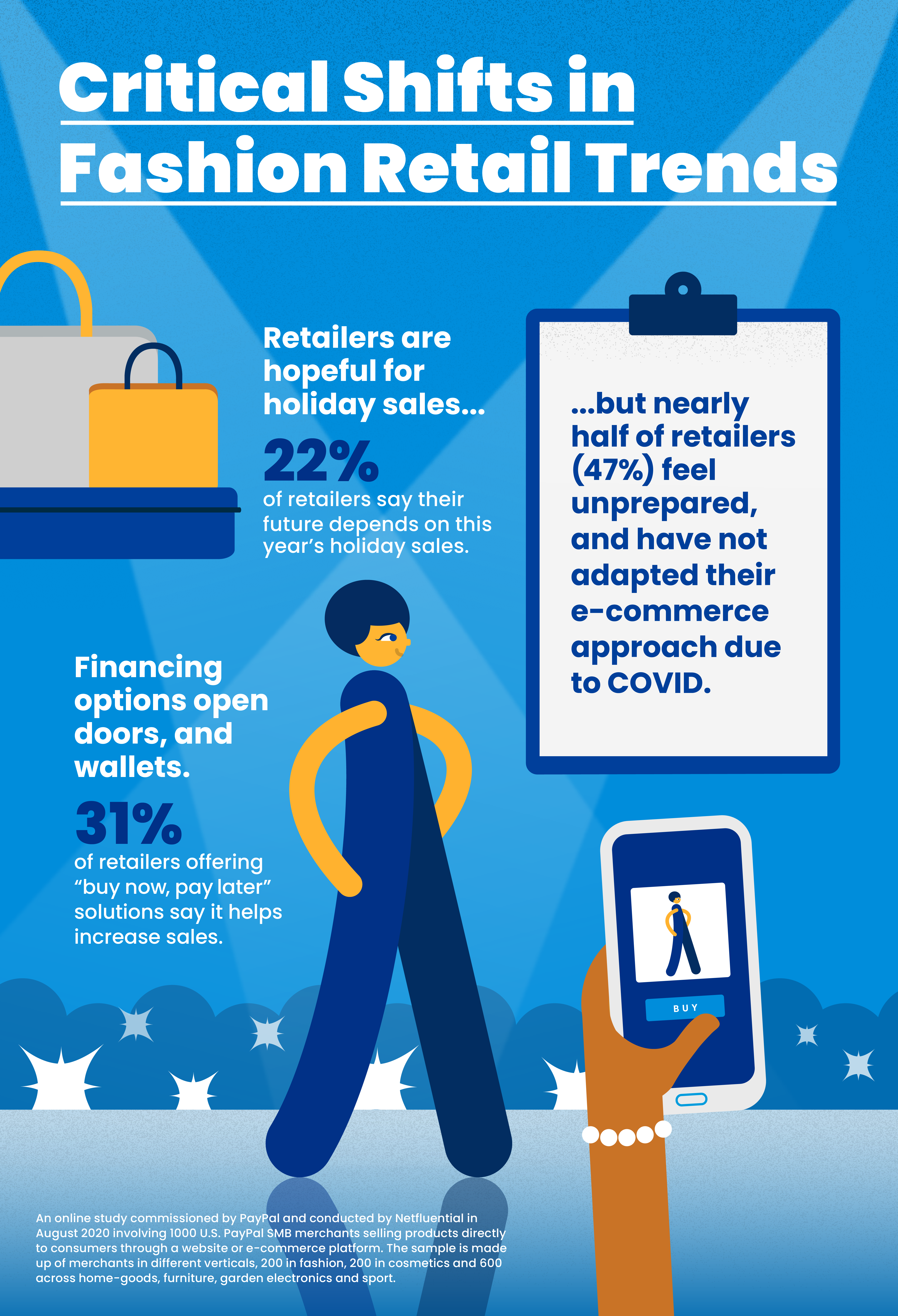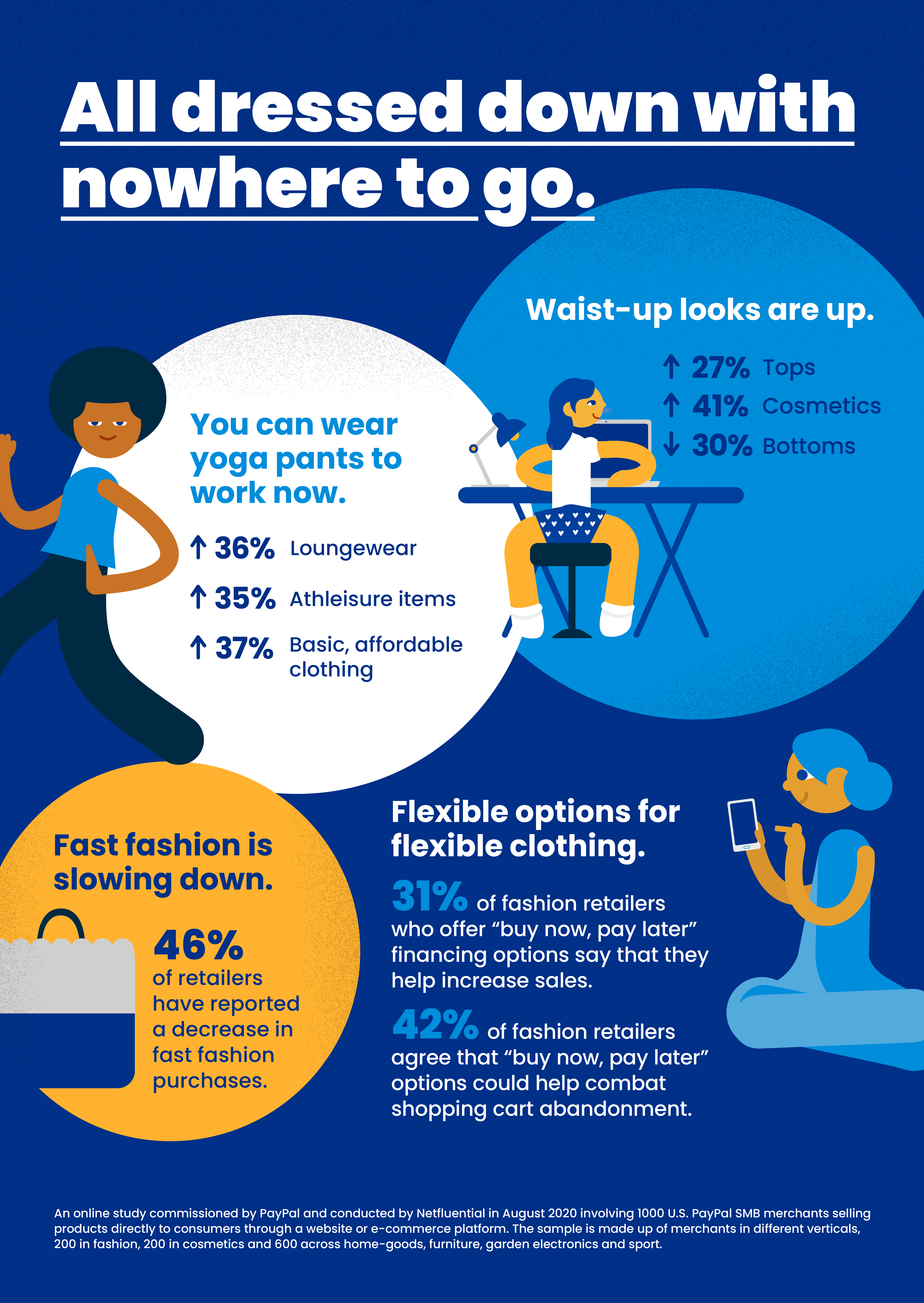COVID-19 has Changed the Fashion Industry. Here's How Retailers Should Prepare for Holiday and Beyond.
Product PayPal Innovation Buy Now, Pay Later Research and Insights
The holidays are typically one of the busiest times of the year for fashion retailers, and with nationally recognized days dedicated to shopping like Small Business Saturday and Cyber Monday, the end of the calendar year also tends to be the most lucrative.

View Image | Download PDF
But this year, the coronavirus (COVID-19) pandemic and economic recession have caused major shifts in consumer behavior that pose uncertainties for shoppers and retailers alike. Major events in the fashion world like New York Fashion Week (NYFW), which typically draws thousands of visitors from around the world, look different this year—with capacity limitations, outdoor events, and safety regulations. How can consumers and retailers adapt?
A recent online study of 1,000 U.S. PayPal e-commerce retailers provides some insights1. The study, commissioned by PayPal and conducted by Netfluential, examined how COVID-19 has caused fashion retailers to adapt. The results reveal that many fashion retailers feel overwhelmed: nearly half (47 percent) reported feeing unprepared for the holidays, with about a quarter (22 percent) saying their future depends on holiday sales—making it even more important for retailers to adapt and start preparing now.
Small and medium sized businesses in the fashion industry often struggle to keep up with ever-changing consumer preferences and behavior, even more so during COVID-19 uncertainties. “This is no doubt a challenging time, but it is also full of opportunities if businesses are nimble and open to change,” said Greg Lisiewski, Vice President and General Manager of Global Pay Later Products at PayPal. He recommends that retailers explore altering their product offerings, expanding their payment methods, or shifting to online advertising strategies.
This NYFW, Lisiewski shares insights for how fashion retailers can best prepare in advance of the holiday shopping season.
1. Embrace e-commerce.
Almost half (47 percent) of fashion retailers have not adjusted their e-commerce approach since the start of COVID-19, despite a massive consumer shift toward online shopping. As consumers are wary of in-person shopping and retailers abide by social distancing recommendations, online shopping offers a convenient and safe alternative.
“Online shopping has been steadily growing over the past several years, but we have seen a massive acceleration during the pandemic,” said Lisiewski. “This is a coming-of-age for e-commerce, and it’s here to stay well past the pandemic.” He noted that the businesses that were quick to adapt—those that added new features, expanded their websites, or changed their advertising methods—have been the most successful in converting former in-store foot traffic to online traffic.
This shift is about more than being able to purchase apparel—it is about the entire online shopping experience. Lisiewski said that many retailers are getting creative as they seek to differentiate themselves from competitors during COVID-19 by selling face masks, offering decreased shipping fees, creating virtual dressing rooms, and more. Over half of fashion retailers (52 percent) say they are unsure whether in-person shoppers will use fitting rooms, so many are creating online alternatives, such as virtual fit or sizing tools (26 percent), virtual showrooms (23 percent), and virtual stylists (23 percent).
2. Expand financing options.
With the recession increasing the number of consumers looking for more flexible and responsible ways to pay, many retailers are expanding their payment options to drive sales and sway customer choice. The study found that 42 percent of fashion retailers agree that “buy now, pay later” options such as Pay in 4, which is part of PayPal’s suite of pay later solutions and available in Q4, can help combat shopping cart abandonment and increase sales. Pay in 4 enables retailers to get paid upfront while customers pay four interest-free installments over time and is launching just in time for the holiday season.
“Consumers are excited to be able to pay [with pay later options] because it gives them more control,” said Lisiewski. “It helps consumers in the midst of these uncertain times with a tool that helps manage their cash flow.” With offerings like Pay in 4, customers can align their expenditures with their income without interest or additional costs.
These flexible payment options are also beneficial for retailers who want to tap into PayPal’s platform of over 346 million active accounts. “We can drive a demand for retailers while solving a consumer need from both sides of the shopping equation” said Lisiewski. “In a sea of chaos, we can cross ‘flexible financing options’ off of a retailer’s to-do list, allowing them to focus on running their business.” Pay in 4 is part of retailers’ integrated solutions with PayPal, so no additional fees are required to implement the payment option.

View Image | Download PDF
3. Adjust to meet COVID-19 fashion trends.
The shift to remote work, video calls and virtual social gatherings has made consumers more pragmatic in their approach to fashion. Not surprisingly, fashion retailers report seeing an increase in sales of “waist-up” apparel, with a 27 percent increase in sales of fashion tops, while sales of pants and skirts are down nearly the same proportion (30 percent). To meet consumers’ demand, retailers can focus their efforts on buying, selling, and advertising for the waist-up fashion trend.
COVID-19-related pivots are not the only way retailers can meet consumer preferences. “Customers are aligning with retailers that reflect their core values, whether that’s along social or environmental lines,” said Lisiewski. Almost half (46 percent) of fashion retailers who sell “fast fashion” items—those that are replicated quickly and inexpensively from runways, often at the expense of the environment—have reported a decrease in customer purchases. “Brands that take strong stances will win more customers,” said Lisiewski, adding that PayPal CEO Dan Schulman often encourages everyone to “do well by doing good.”
For Lisiewski, the best way for brands to engage shoppers is by listening to consumer preferences, monitoring shopping behavior, and creating products that meet shoppers’ needs. Especially at a time when so much is changing, it is critical to have consumers in mind from the very start.
While the study reveals challenges within the fashion industry, its learnings can also empower retailers to prepare for the upcoming holiday season and beyond. After all, the fashion industry is not going anywhere—even if the holiday shopping season looks different this year.
To learn more about PayPal’s newest pay later option, Pay in 4, click here.
Watch the Vogue Business webinar: “Making the most of shifting consumer demands in U.S. fashion,” to learn more about the changing shopping landscape and ways fashion retailers can prepare for the holidays.
1 "An online study commissioned by PayPal and conducted by Netfluential in August 2020 involving 1000 U.S. PayPal SMB merchants selling products directly to consumers through a website or e-commerce platform. The sample is made up of merchants in different verticals, 200 in fashion, 200 in cosmetics and 600 across home-goods, furniture, garden electronics and sport."